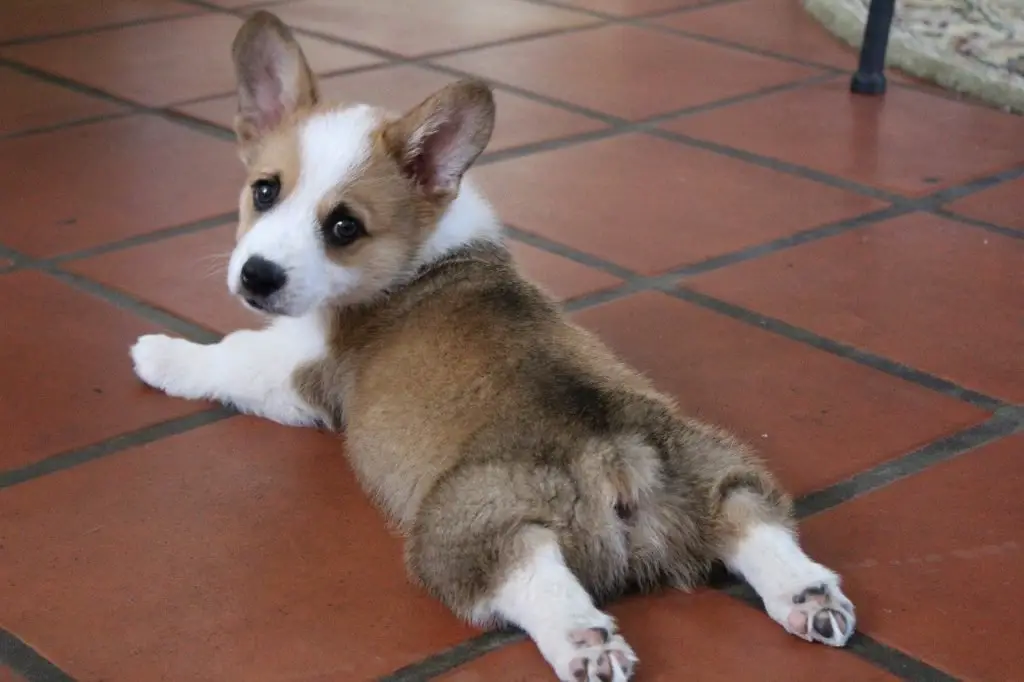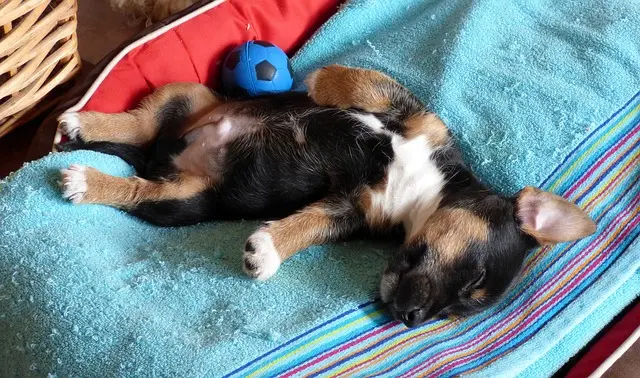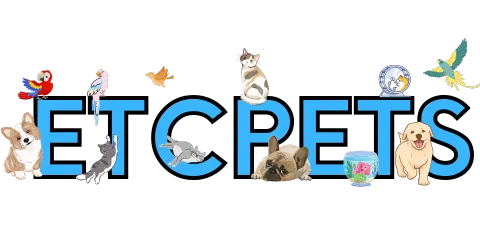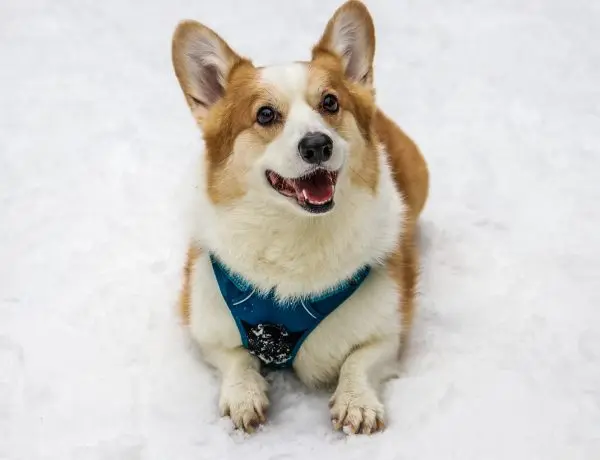The term splooting has become more popular over the past decade when people talk about their pets and some of the crazy things they do. But what exactly does it mean and where did it come from? Neither of us was familiar with this term before, so we decided to look into it. Here is what we found out!
Splooting is a newer term for a rather old and common occurrence. It is a coined name for when dogs (or other animals) lie down on their bellies and put one or both legs stretched out behind their bodies, much like what is typically described as a super dog or frog-leg pose.
Dogs, cats, as well as many other animals, have plopped themselves down in this “pose” for ages. The name for it, “splooting,” however, is a relatively modern term given to describe it.
Table of Contents
Why Is It Called a Sploot?
We tried in earnest to discover the etymology of the word, but so far have been unsuccessful in finding its origin. We were, however, able to narrow it down quite a bit. The term first became popular with social media, describing Corgi puppies and how they would lay down on the floor – with their front paws stretched forward, and their hind legs stretched back behind their body. As far as most guesses go, it was named “sploot” to describe how they laid as a “splat,” and it was “cute.”
As far as when the phrase was first coined, we were unable to find an exact date, but we were able to narrow it down to somewhere around 2010-2011. I even went so far as to pilfer through Google search results, adjusting the year to display results in 6-month increments as well as searching Wayback Machine for any older sites that may have fallen by the wayside.
Towards the end of 2010, there were a few mentions of the term used, but not many. Then in 2011, it seems to have taken off. There were quite a few videos on YouTube, like this one here and Reddit posts.
What Are Other Names For Splooting?
Splooting has also been known by many other nicknames in the past. Depending on how far back you go, the labels given to it will vary.
Other nicknames we were able to find include:
- Frog-dog
- Frog pose
- Frog legs
- Frogging
- Frog-fu
- Flying squirrel
- Furry turkey
- Splatt
- Turkey legs
- Drumsticks
- Supermanning
- Lazy sit
- Frog-sit
- Flying squirrel
- Pancaking
I am sure there have been many more ways to describe this adorable pose over the years.
If you happen to find any, please let us know in the comments below. I would love to add them to this list!
Can Only Purebred Dogs Sploot
Purebred dogs being the only dogs that can sploot is actually a misnomer. Most of the thoughts behind that are because of an old-wives-tale that implied if a dog liked to do the “frog-dog” pose, it meant they had good hips.

Purebred dogs from responsible breeders usually have their hips tested before the breeding takes place. Because of this, they ordinarily have better hips than a random dog you may find off the street.
The fact is that any breed of dog CAN sploot; whether they choose to depends on if it is comfortable for them. The ability does not lie only with dogs, however.
Cats, as well as several other animals, are commonly taken in as pets, such as rabbits, hamsters, gerbils, guinea pigs, etc., are fully capable of doing so.
Are There Different Types of Splooting?
Although you may find a few people claiming more types of “poses” to be sploots, such as lying on their backs or sides, there are commonly three positions referred to as a sploot.

The Full Sploot – This is the most common pose referred to as a sploot, and what the Corgi puppy pictures were famous for that blazed across social media. It is when both legs are extended fully behind their rump, making the classic “frog pose.”

The Half Sploot – When they keep one leg (either one) tucked up under their belly, and have the other leg sprawled out back behind their body, just like they would with a full sploot. This one is common, but it is not as frequent to see quite as many pictures on social media.

The Side Sploot – This is a mix between the full sploot and the half sploot. This is where they have one of their legs (either one) tucked under their belly still, and the other leg is sticking out to the side of their body.
While the positions lying on their back and sides are remarkably cute and can make excellent pictures, I don’t believe they fit the regularly accepted definition of a sploot. These would have other nicknames associated with them.
Why Does My Dog Sploot?
There has been quite a bit of speculation and old-wives-tales, which I will get to shortly, as to why they do it. There have not been any studies conducted that confirm any of the theories one way or the other, as far as I was able to find.
The best guess (and the one I would go with) is simply because it is comfortable for them when they do so. Much for the same reasons as to why some people sit with their knees to their chest, whereas I could not imagine sitting in a more uncomfortable position. Or when some people stretch, they will reach down and touch their toes. I can barely do that, so I have other ways I stretch that work better for me.
When animals lie down in this position, it is merely because it is comfortable for them to do so. For others, it is a comfortable way for them to stretch out their legs, hips, or spine. Another theory is that when they are spread out like this, it helps them to drop their body temperature and cools them off faster. There may be a few other reasons for them doing so, especially for older dogs, but we’ll get to that soon.
Why Does My Dog Not Sploot?

With dogs, it seems that shorter-legged breeds tend to sploot more than breeds with longer legs. For long-legged breeds, it may feel more awkward for them to sit or lie down in certain positions like splooting.
Originally, Corgis (specifically Pembroke Welsh Corgis) caused the sploot to become famous across social media. Still, Keeshonden, Pugs, French Bulldogs, Boston Terriers, Bulldogs, about any of the bully breeds, even mixes such as pit bulls, etc. are all apt to want to participate in this posture. While not as common, other breeds such as Collies, Rottweilers, Labradors, etc. can do it as well.
In most breeds, puppies seem far more apt to be caught lying down in this manner than grown-up dogs. While they are young, they are typically more flexible, and it is more comfortable for them to do. As they get older, they may find their hips or other parts of their bodies will stiffen up some, causing them to find less comfort in doing it.
Some breeds that are more susceptible to having hip dysplasia might find it less comfortable to get into this position, thereby making it less common of a sight to see those breeds splooting.
If your dog doesn’t like to sit or lay like this, don’t force it. It just simply means that it is not comfortable for them to do so. While it could be because the dog lacks the flexibility, it could also be because their hips are what make it uncomfortable for them, and forcing it could potentially cause issues!
Is splooting bad for dogs?
First, let’s get back to the few old-wives-tales I heard that I mentioned earlier. Some breeders and animal owners have suggested that if a dog lays down in a “frog-pose,” it means that they have good hips. Others still have stated that it means they have bad hips, or could possibly develop bad hips due to their propensity to lie in such a position. As I mentioned above, I could not find any study at all that specifically claimed either case was valid. Nor could I find any that refuted them either.
I would suggest that if your dog (or another type of animal) is prone to relaxing in this position, keep an eye on them. You can mention it to your vet the next time you go in, and see if they seem concerned about it. Otherwise, just keep an eye on your pet and how they walk afterward. If they are starting to develop a limp, you may want to try to get them to lie down in a different position for a week or two and see if it gets any better. When in doubt, ask your vet!
The caveat to this is if your dog was never typically a splooter, and you see them start doing it all of a sudden now that they are older.
In this case, I would recommend seeking a veterinarian’s opinion and see if they think something could be wrong.
Some of the possible causes for them starting to do it now that they are older could be to help relieve some pain they are suffering from. This pain could be from hip dysplasia, osteoporosis, arthritis, torn ligaments, or other trauma caused by a recent injury. In these cases, it more than likely will not make it go away, but it could make it worse.
Other Things of Note
While for the most part, dogs will “sploot” when it is comfortable for them to do so, it also is a position you want to be careful with them in. While it is perfectly fine in most cases to let them continue lying in that position, you want to make sure you are not rough with them while they are doing so. Having their bodies stretched out like this and then getting pulled on or played rough with could cause them to get injured.
Some of the injuries could include trauma to a joint, tearing a ligament or muscle, scraping their skin on the surface they are on, as well as others. That especially applies if you are taking your dog for a walk and decide to stop and assume this position. The last thing you should do is pull them by their leash. Let them take a minute; it could be they just needed a quick stretch. If they don’t get up to start walking after their stretch, pick them up and set them on their feet before you start tugging on the leash.
While, for the most part, splooting is harmless and provides quite a few amazingly cute photo opportunities, the critical element is to know your dog and their tendencies. If it is normal for them to sploot, feel free to let them continue to do so. Keep an eye on them as they get older, though, and see if they appear to be developing hip problems.
With my Pembroke Welsh Corgi, he used to love to sploot when he was younger. Specifically, right in my hallway where I had to step over him constantly! As he has gotten older, I have noticed that he tends to do so much less now, and will only occasionally do a half or side sploot. Now, he prefers lying on his side or his back the vast majority of the time (yes, still right in the middle of the hallway!)
If your dog starts splooting later on in life, and it has not been a normal tendency for them to do so, have your vet check them out.




